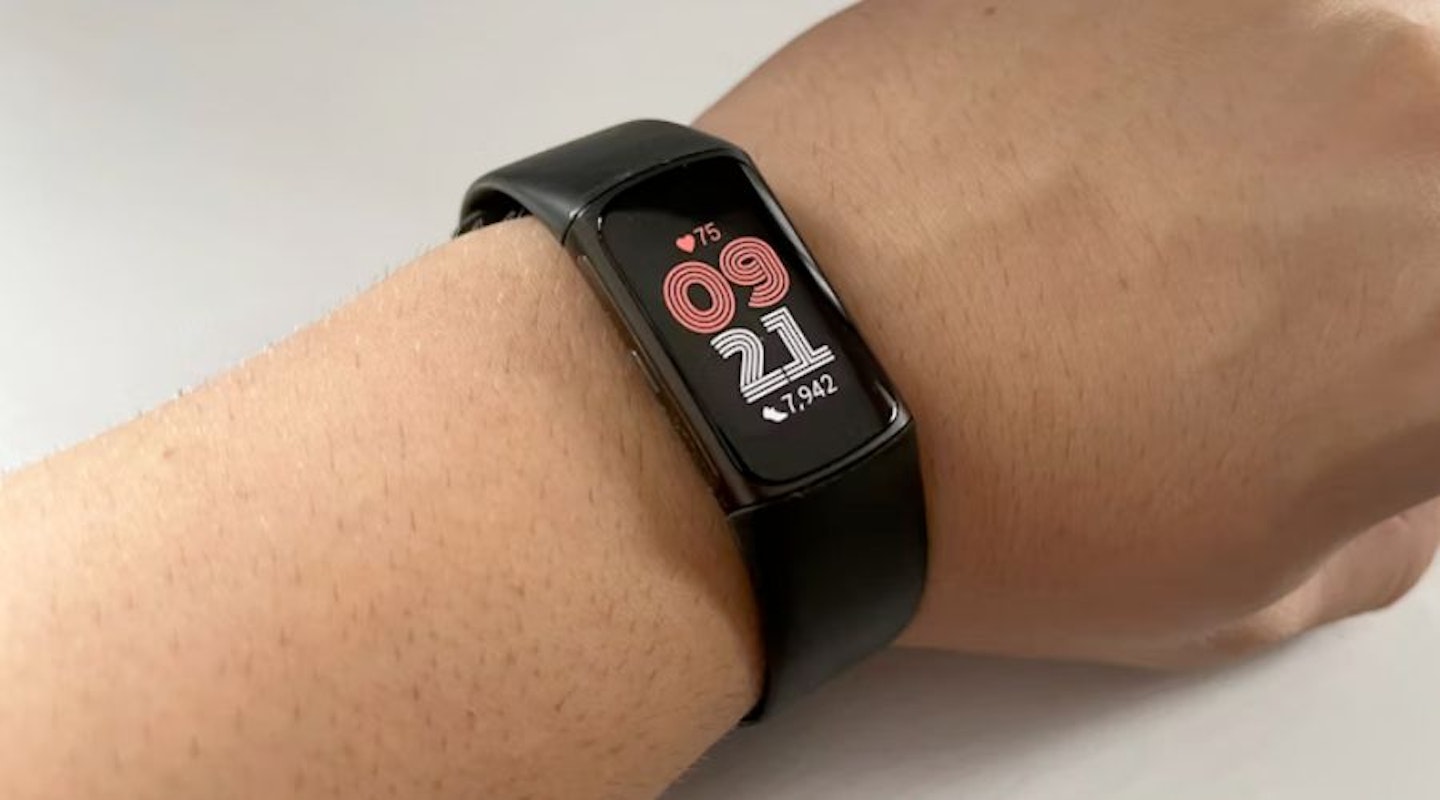The Withings ScanWatch Light is Withings’ entry level watch, released at the same time as the more expensive ScanWatch 2. It’s the cheapest of the line-up but not by any significant margin. It’s available in five unique colours: Black, Silver, Green, Rose Gold Blue, and Rose Gold White.
While the classy yet modest design might fool some, the ScanWatch Light is equipped with some familiar health and fitness features. There’s built-in GPS, Heart Rate Tracking, sleep tracking, cardiovascular notifications, Advanced 24/7 Activity Tracking, and even Menstrual Cycle Tracking. Running alongside the Withings Health App, you can pair the ScanWatch Light with your smartphone via Bluetooth and gain a wider understanding of your health and fitness, as well as the features within the watch.
Join resident Digital Writer and Tech Reviewer Jack Barrell in determining how well the Withings ScanWatch Light blends the functionality and tradition of a wristwatch, with the innovative nature of a modern fitness tracker. This is the comprehensive What’s the Best review.
 Amazon
AmazonJohn Lewis & Partners
Pros
- Very smart and polished design, makes it perfect for professional and casual settings
- Set up is easy, Withings app is simple and intuitive
- Strap is very adjustable, perfect for all wrist sizes
Cons
- Poor button placement – can interfere with workouts
- Minor fitness inaccuracies or reading delay
- Quite fiddly to navigate during intense workouts
| Display | Grayscale OLED |
| Battery life | 30 days |
| GPS | Built-in |
| Water resistance | Up to 50m |
| Compatibility | Android, iOS |
| Dimensions | 23.9 x 3.81 x 0.99 cm |
| Weight | 45g |
Unboxing and getting started
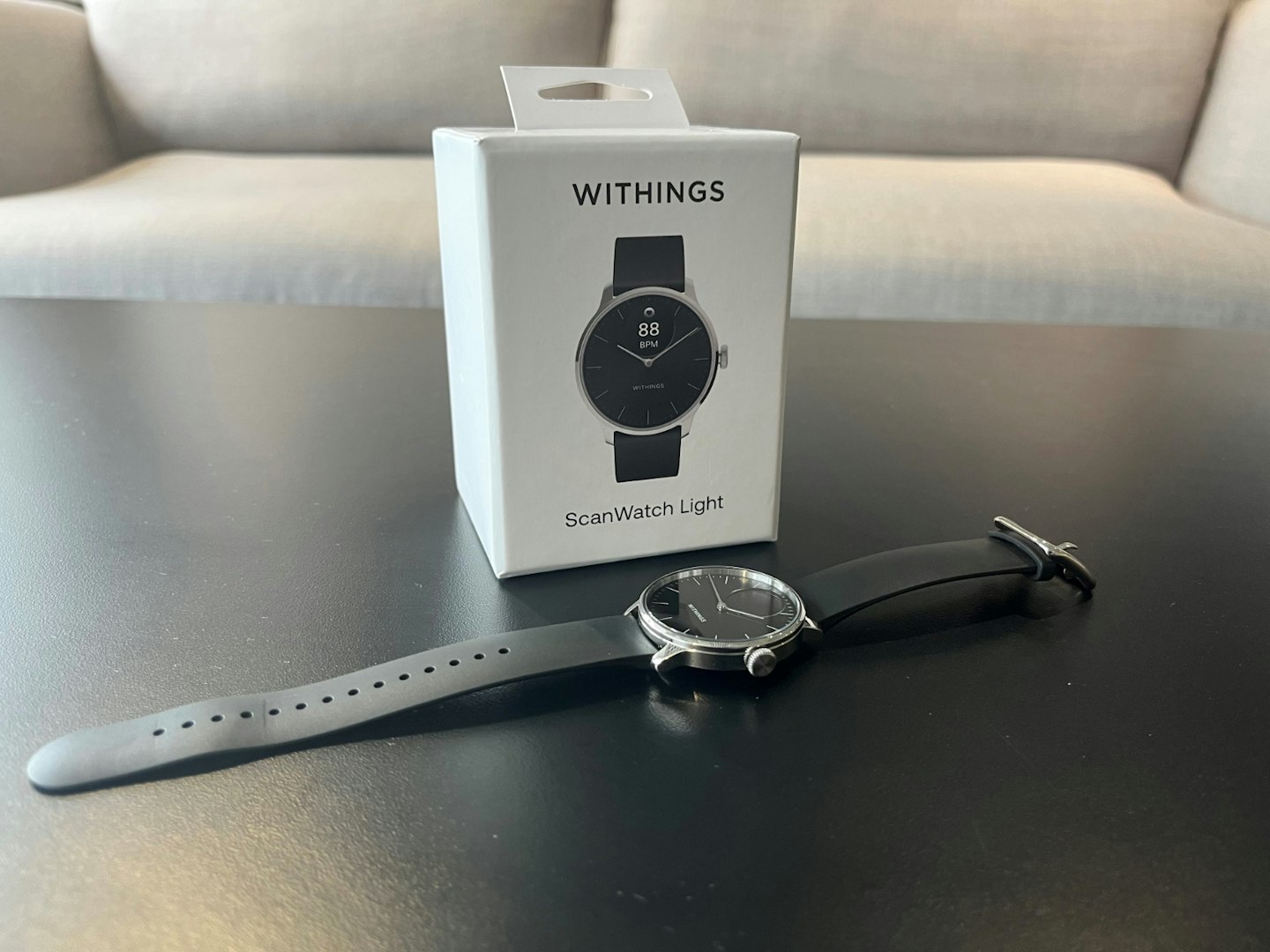
Taking the ScanWatch Light out of its packaging was as simple as I’d hoped. Like many contemporary fitness trackers and smartwatches, it came in compact boxing which I found easy to disassemble.
Following the clear setup instructions on the side of the box, I downloaded the Withings Health App to my iPhone. Adhering to the common setup method for fitness trackers and smartwatches alike, this app is where I got the ScanWatch Light up and running. Before this, I did have to charge the watch from around 50% to full charge, thankfully, this didn’t take any longer than half an hour. The in-app setup process was clear and concise, it explained exactly how to navigate the watch’s controls. I was also able to log my initial health and fitness preferences, including all my personal information, as well as any goals or targets that I might want the Withings app to help steer me towards.
Fit and functionality
I can’t fault Withings whatsoever when it comes to how adjustable they’ve made the ScanWatch Light. The nylon strap (which is very comfortable), comes with a whopping 14 punch holes. If this strap somehow doesn’t fit you, I can only assume you have the wrists of a newborn or a gorilla.
It’s comfortable for the most part at least, I had no problems wearing all throughout the day. Only at nighttime would it sometimes irritate me, just based on the size and shape of the watch face, something like a Fitbit Charge 6 sits far more streamlined on the wrist.
Interacting with the ScanWatch Light seemed straightforward at first glance. There’s a singular dial on the right side of the watch face, you can scroll through the basic metrics and click it in to select. This control style is probably the second most hybrid-esque aspect of the watch, aside from the obvious 2-in-1 interface.
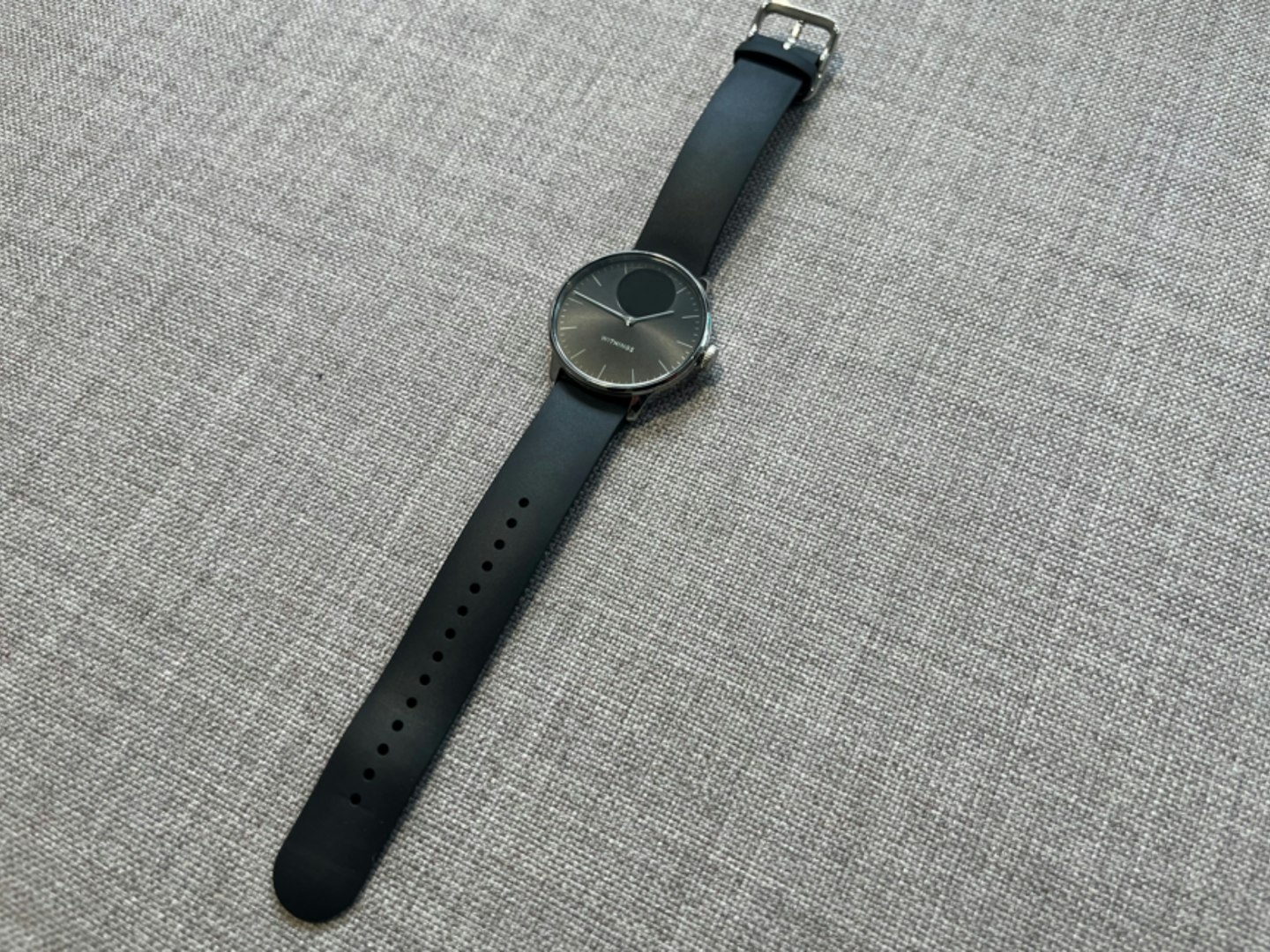
Sophistication meets fitness infatuation
At face value, I absolutely love the look of this hybrid smartwatch. From a quick glance, you’d easily mistake it for a simple, stylish wrist accessory. I’d argue that that’s where hybrid smartwatches are truly at their best, and it’s what I imagine the ideal customer is looking for. High-tech smartwatches are wonderful, but you lack the subtlty of a classic watch. I’ve worn the ScanWatch Light at the work office, to a christening, down to the shops, and even out on a walk in the sticks. It’s been designed tastefully enough that it can make a perfect fashion accessory to any upscale event, yet it wouldn’t look out of place in any casual or day-to-day setting either.
The clock face is elegant, and the LED screen sits at the top portion. If the clock hands happen to be covering the display at a time where you want to view it – the hands will automatically shift to a 10 and two position, opening up a clear view of the screen. If you've been stuck between picking a smartwatche or a fitness tracker, the ScanWatch Light does well to bridge the gap from a design standpoint.
What you see on the mini display is mostly customisable too, I’ll touch on this more when I get more into the Withings Mobile App. Flicking through the features and options is a breeze too, sometimes it would flick through two by mistake, but this became less frequent the more I got used to the control sensitivity.
If you never touch the control dial, you’d never know it was a hybrid smartwatch. There’s no wake function where you raise your wrist and the screen lights up – a typical feature in many smartwatches and fitness trackers. It might be stating the obvious, but a nice aspect to hybrid smartwatches is that you'll never have to change to battery like you would a bare bones wristwatch.
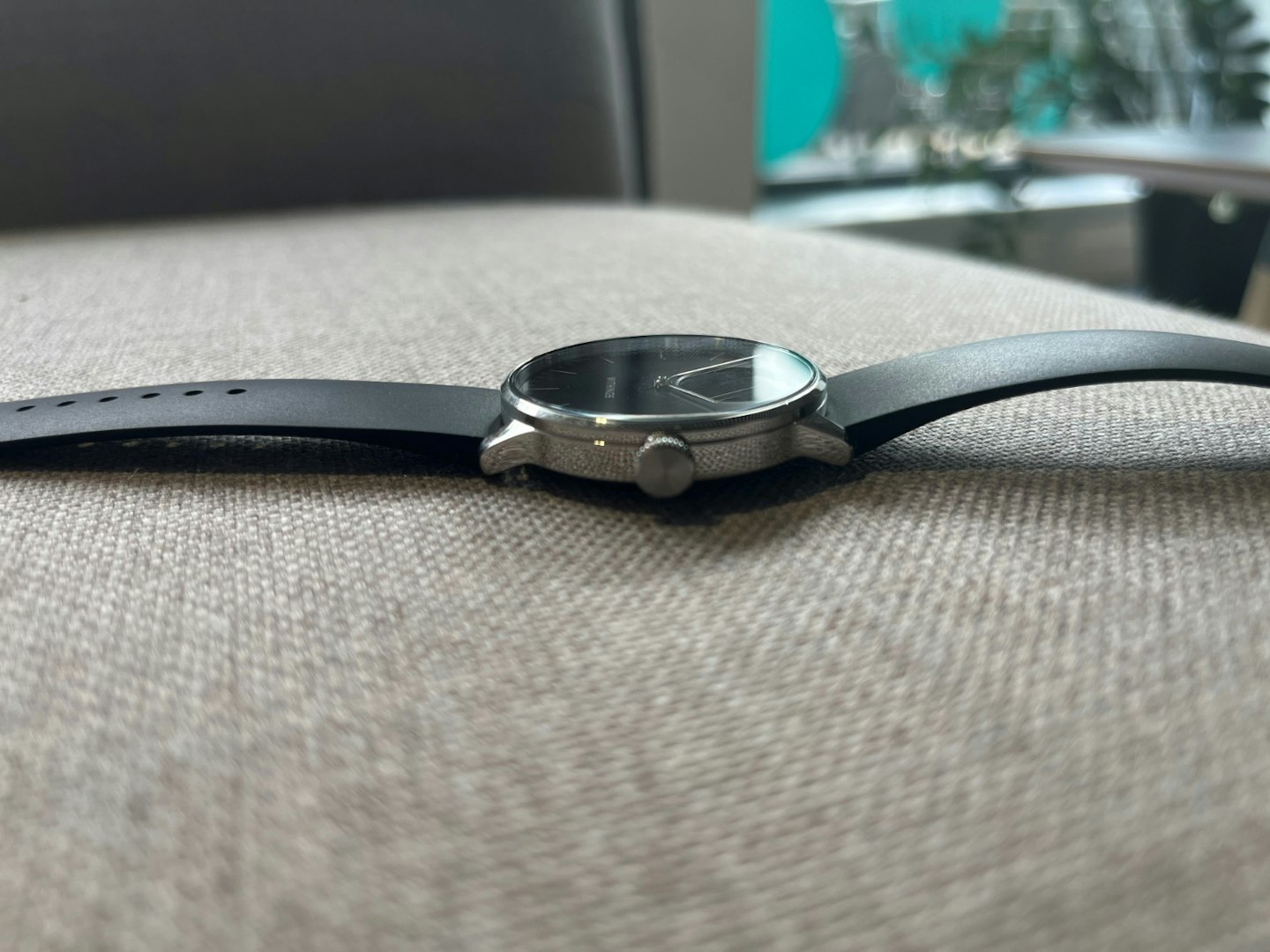
Features
Despite the modest exterior, there’s plenty to get through where features are concerned. GPS was an unexpected standout for me, even though it's not built into the ScanWatch Light. Like with the best GPS trackers, I really enjoyed going for a walk or a run, and reviewing my post activity report on the mobile app. The GPS relies on the Bluetooth connection with your smartphone, but it does so incredibly well. It uses the GPS with pinpoint accuracy to show exactly where you travelled, even detailing your heart rate and calories burnt throughout the trip. It's not as if because the GPS isn't built-in with the ScanWatch light, then Withings just hasn't bothered. A solid effort has been made to ensure a streamlined smartphone to watch GPS experience, and it really pays off for a hybrid smartwatch.
30-day battery life is brilliant to see, no one is ever going to complain about that. Of course, this is mostly down to the nature of the device in the sense that it doesn’t have a large screen and its very functionally minimalistic. Regardless, 30 days of battery is always impressive – and it’s still an impressive fact that the ScanWatch Light can perform the fitness tracker functions that it does in such a compressed format.
A water resistance of up to 50m was a pleasant surprise too, and quite surprising given the sophisticated design. I wore the watch out in the rain, as well as in the shower, and I ran into zero issues regarding waterproofing.
In the spirit of an effective fitness tracker, the ScanWatch Light offers a range of activity modes, way more than I expected to see. Again, you can customise which ones appear on the face via the linked app. Each activity mode measures different metrics depending on the exercise or sport, while not always entirely accurate on the watch, the app gives a clearer picture post session. I want to point out that when using one of these activity modes, you get the option to view your live metrics on your smartphone. This a very neat feature as it opens up the experience and compensates for hybrid the nature of this watch. Small display? No problem, take advantage of this smartphone link.
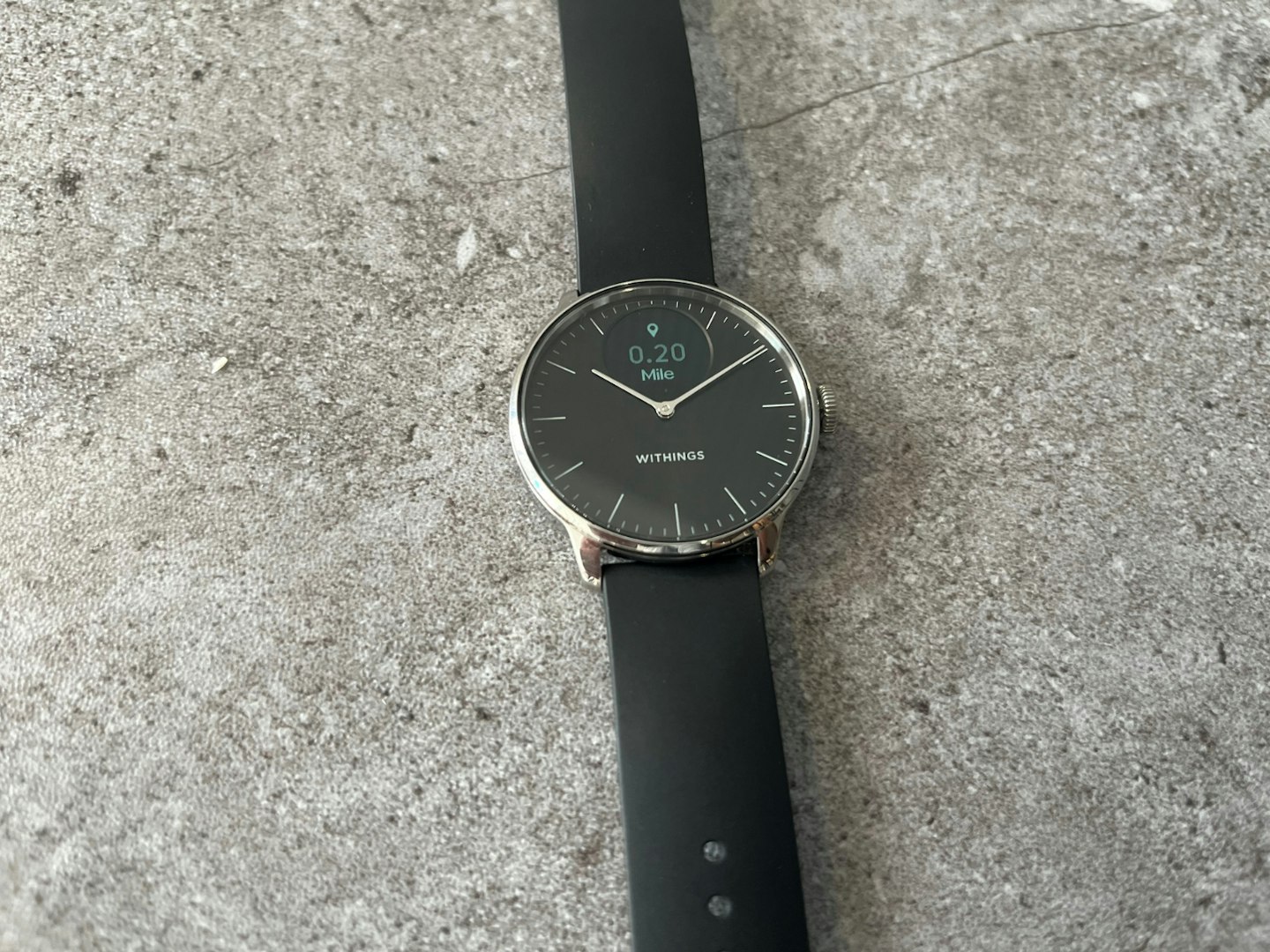
Withings Health App
I’ve had a really positive experience with the Withings Health App; the hub of the ScanWatch Light and any other Withings gadgets. For starters, the app is really well designed, it fits the theme of a hybrid smartwatch to perfection. I’m a big fan of the default darker theme too.
The app is separated into three main sections, navigated via icons at the bottom of the screen. First is the Home tab, this serves as a bit of an overview. Here, I was able to view my current daily metrics including steps, calories burnt, average heart rate, recent activity, and sleep tracking. This is all really well laid out, there’s a little time stamp on each section which indicates the last time a metric was taken.
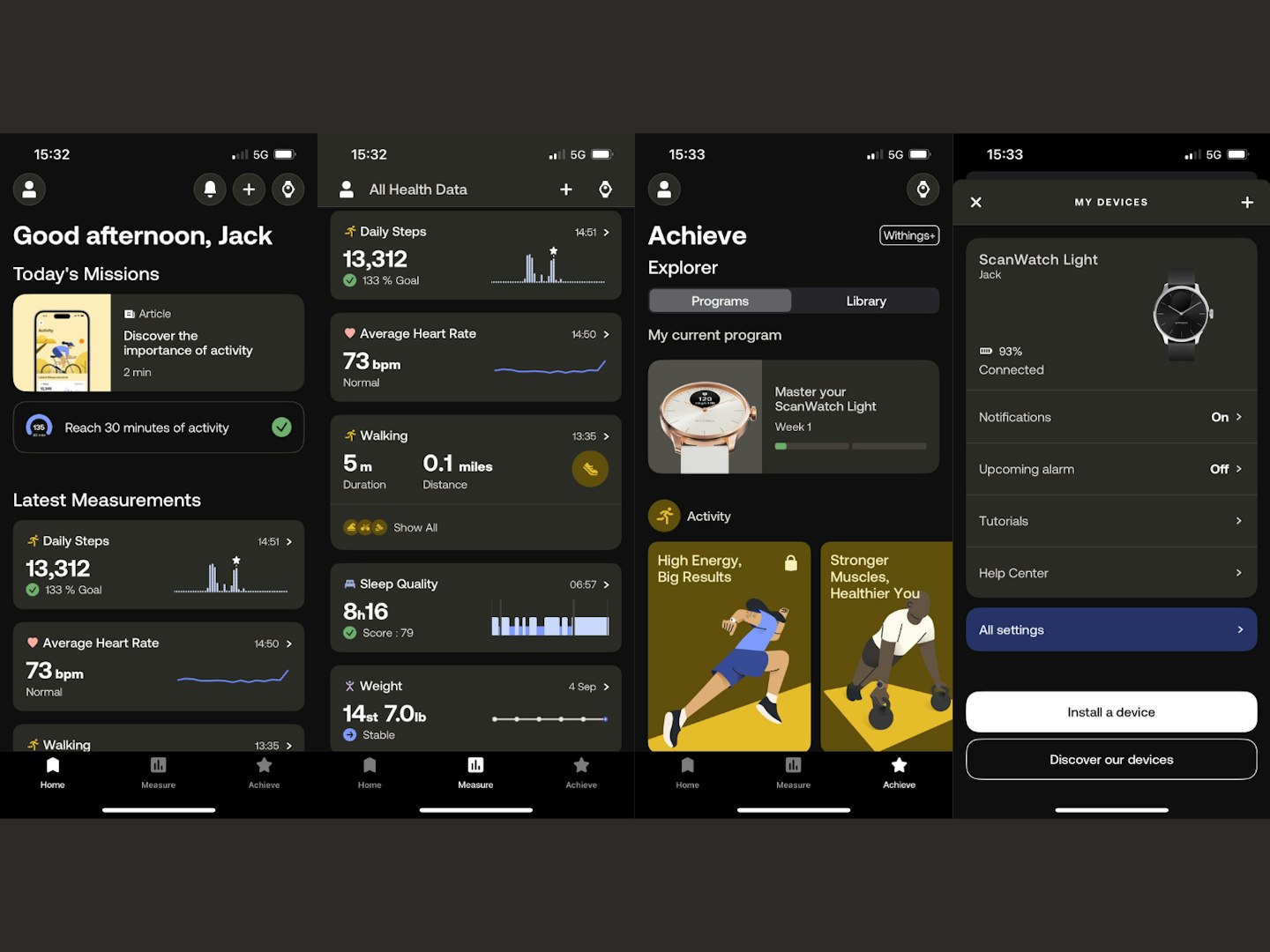
Something I noticed instantly about the app was how quickly it would synchronise with the ScanWatch Light. I’ve used fitness trackers previously where the synchronisation process has taken significantly longer than I’d have liked, but the Withings Health App would take barely a few seconds.
Withings+
In similar fashion to a lot of fitness trackers, there's a paid subscription which unlocks more in-app features for the Withings Mobile App. Withings+ is promoted as a way to level up your health through a health improvement service. Essentially, you get access to exclusive metrics, workout and training content, and more advanced goal setting and management.
For £8.95 per month or £89.50 annually, I personally don't think you need Withings+, especially with the ScanWatch Light. The watch is already mostly limited with its fitness tracking capabilities and accuracy, and there are far better paid subscriptions for far more accurate devices out there. If you're after a comprehensive and detailed fitness experience, I'd generally advise picking out a dedicated fitness tracker as opposed to a hybrid smartwatch.
What's holding it back?
Despite the refined look of the ScanWatch Light, I did unfortunately find that the hybrid smartwatch isn’t as squeaky clean as the looks had me first believe. I took into account that this is a hybrid smartwatch, it isn’t a dedicated fitness tracker nor is it a devoted smartwatch. That being said, I can’t ignore the problems that exist within these hybrid elements.
Firstly, I found both fitness reading inaccuracies and reading delay. Regarding inaccuracies, I started a weightlifting session and used the watch’s activity mode. I trained intensely for around an hour and the ScanWatch Light display told me I’d only burnt a grand total of five calories. Strangely, after I finished my session and headed into Withings app to check the data, the calories burnt had updated to a more realistic 500-odd calories.
There’s some reading delay when it comes to the heart rate monitoring. The ScanWatch doesn’t monitor your heart rate at all times, whether this was intentional or coincidental, I couldn’t quite figure out. It did however make reading my heart rate rather tedious at times. I’d often check the display and scroll to the heart rate function to find myself staring patiently at the screen for more than a few seconds at times before I even got a reading. This same display would often tell me my last measured heart rate and how long ago that was, which I didn’t find ultimately that helpful.
Even though the side dial control does work really well for the aesthetic of a hybrid smart watch, I did run into trouble from a functionality standpoint. In order to come out of an exercise mode, you have to press and hold the dial. A new image will pop up asking if you’d like to pause or completely stop the activity. Despite wearing the watch correctly, there were multiple occasions where I’d accidentally pause or cancel my activity due to slightly bending my wrist or placing my hands on my hips – leading to the dial being pressed. This was extremely frustrating, the last thing I wanted to be doing was worrying and fiddling about with the watch once I’d hit start activity, but there I was.
Price and competition
Value-wise, I think that there’s a lot more out there worthy of the ScanWatch Light’s £229.95 price tag. You could pick yourself up a dedicated fitness tracker in the Coros Pace 3 for £10 cheaper than this. Equally, if you wanted to go the smartwatch route, you could pick up an Apple Watch SE – again, for £10 cheaper.
If you’re dead set on a hybrid smartwatch, you might potentially want to consider the Vívomove Trend from Garmin. This one’s around £50 more than the ScanWatch Light, but the experience is far more polished and refined.
Ultimately, when you pin the Withings ScanWatch Light against competitors within the hybrid smartwatch market, visual design might be all that sways you in its favour. It looks the least like a fitness tracker or a smartwatch, so if that’s what you’re after – this’ll be the one. It’s the most stylish and fashionable by a far stretch, and the additional colour options hold the same standard too.
Who is it for?
I believe the ideal wearer of the Withings ScanWatch Light is someone who is after a fashionable, charming wristwatch, that has some minimalist functions of a fitness tracker. In no world can I see this watch being a replacement for a fully dedicated fitness tracker, just like it can’t compete with a digital smartwatch. Despite some impressive tech like accurate GPS and sleep tracking, the Withings ScanWatch Light is going to be a fashion accessory first, and anything else second.
Would we recommend it?
What’s the Best recommends the Withings ScanWatch Light, just to a more niche audience than one might've hoped. To someone wanting to fill the void between a fitness tracker and a traditional wristwatch, the ScanWatch Light will be right up their alley. It does attempt to overachieve in some of its fitness tracking capabilities, and it suffers as a result. But, if you understand its limitations and your needs are basic, you’ll get on with this hybrid smartwatch just fine.
More items to consider
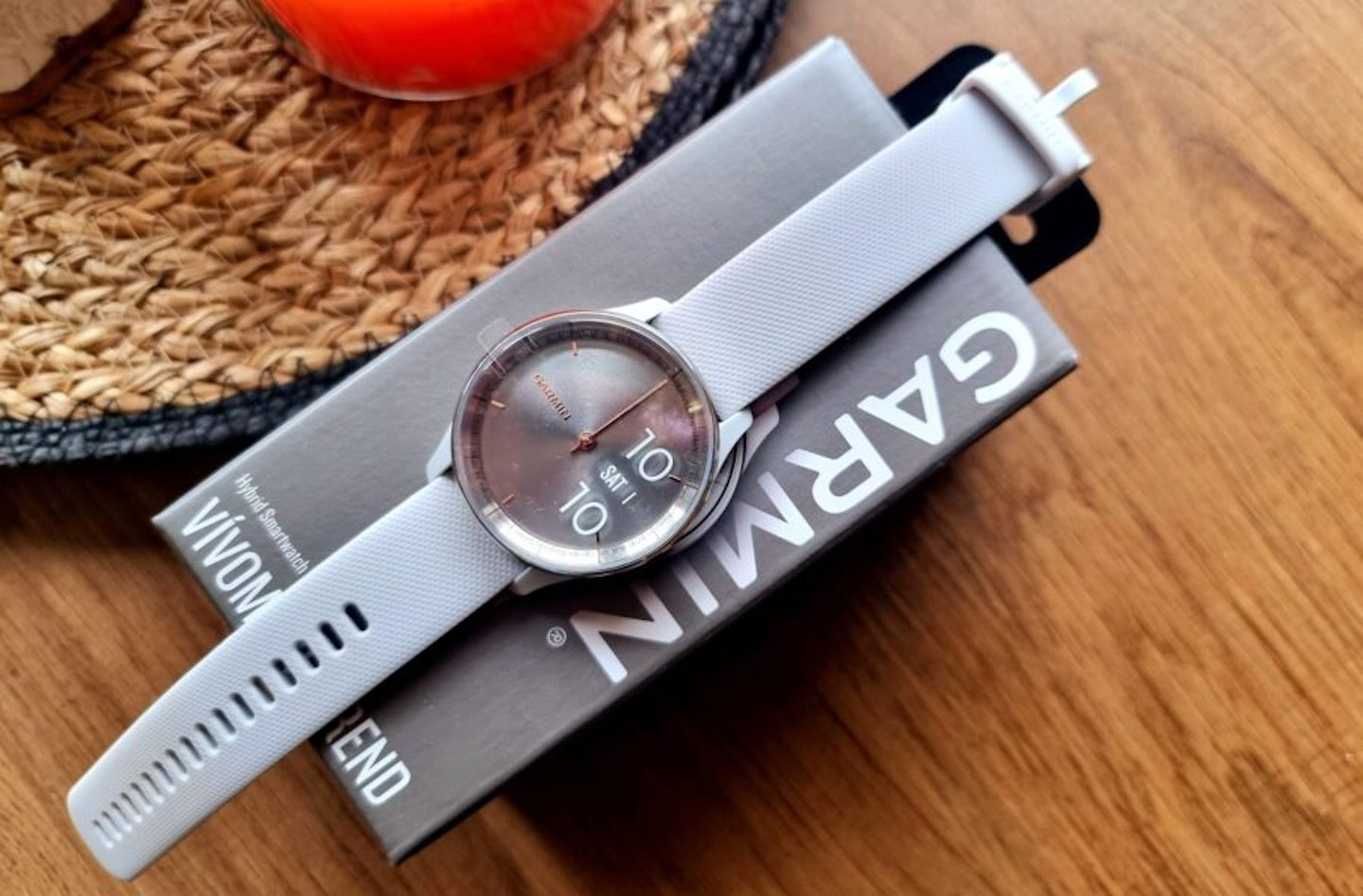
A worthy replacement for the traditional wristwatch that's as smart as it is stylish. Read our full review here.
A full blown fitness tracker option that's capable, fun, and encouraging. Find our more from our full review.
Who tested it?
The Withings ScanWatch Light was tested by our very own Digital Writer Jack Barrell. On What’s the Best, he’s no stranger trying out and reviewing new and exciting tech and fitness products for the site.
How the product was tested
Jack tested this hybrid smartwatch over a two-week period. He wore it daily and nightly, assessing as many of the available features as was humanly possible. He wore the watch during different stretches of exercise including weightlifting, walking, and running, in order to trial the fitness elements of the hybrid device.
While testing the physical watch was a priority, Jack also made sure to get as solid impression of the Withings Health App too. This is where he could find the metrics picked up by the watch, including sleep tracking and exercise reports.
Why should you trust us?
At What’s The Best, our mission is to provide accurate and reliable reviews, ensuring our readers receive honest and transparent information about the best technology products available. Anything less would undermine our commitment to being a trusted source of unbiased product information.
Our dedicated in-house writing team comprises experts with extensive experience and a genuine passion for technology. Collectively, we have spent decades testing and writing about tech, leveraging our expertise in all our articles, advice pieces and reviews.
We maintain complete editorial independence and do not accept payment for product reviews. Our writers have full control over their content, ensuring that products are selected based solely on the needs of our readers. While we may earn commissions or other compensation from links on our website, this never affects our product choices. These links enable us to continue offering valuable consumer advice, without compromising the integrity of our reviews.
How we test products at What's the Best
At What's The Best, we ditch the gimmicks and deliver sweat-tested reviews for real fitness enthusiasts. Our team of experienced athletes puts the latest wearables and equipment through their paces in real-world workouts, from running trails to home gyms. We don't just read specs – we use products as they are intended and push our PBs, so you know what truly performs.
The result? Unbiased buying advice that gets you moving. We only review the most significant and relevant fitness tech and equipment on the market, saving you time and frustration. Can't find a review for your specific fitness goal? We're constantly adding new products to our ever-growing library, so stay tuned.
Jack Barrell is a Tech and Fitness Writer and Reviewer for What’s the Best. He’s an experienced bargain-hunter on Black Friday and Prime Day - finding genuine deals on electronic and audiovisual tech. He is invested in the entertainment space and also keeps well in the loop with the latest sports and exercise trends too. On his off days, Jack can usually be found either in the gym – or watching his favourite Star Wars for the thousandth time.
Subscribe to the What’s The Best Newsletter to keep up to date with more of the latest reviews and recommendations from the rest of the What’s The Best team.


